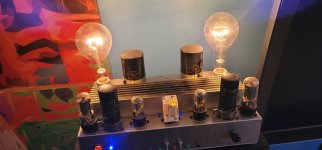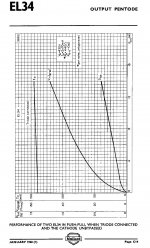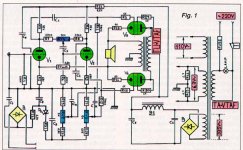3k works better... 2k2 even more... Any tube that uses 10k isn't worth using IMHO -- no worthwhile power.
EL34 doesn't need 8-10K LMAO 3k5 in the damned datasheet.
FWIW 320V, 120mA per tube suits 1k3 using EL519 in triode in my tests. You can get ~100W RMS sine with it.
50mA is better for those weak audio tubes like well almost all of them.
That said, my "little miracle" uses 40mA@320V, and makes 10W in triode, 25W in pentode using EL86
EL34 doesn't need 8-10K LMAO 3k5 in the damned datasheet.
FWIW 320V, 120mA per tube suits 1k3 using EL519 in triode in my tests. You can get ~100W RMS sine with it.
50mA is better for those weak audio tubes like well almost all of them.
That said, my "little miracle" uses 40mA@320V, and makes 10W in triode, 25W in pentode using EL86
Last edited:
3k works better... 2k2 even more... Any tube that uses 10k isn't worth using IMHO -- no worthwhile power.
EL34 doesn't need 8-10K LMAO 3k5 in the damned datasheet.
FWIW 320V, 120mA per tube suits 1k3 using EL519 in triode in my tests. You can get ~100W RMS sine with it.
50mA is better for those weak audio tubes like well almost all of them.
That said, my "little miracle" uses 40mA@320V, and makes 10W in triode, 25W in pentode using EL86
I am sorry I have not made the EL34 triode example randomly. I played with that power stage A LOT. 3K in triode doesn't work at all. With feedback or without it is just poor for me. Once I tried 10K, a proper transformer, there is no way back. 3.5K is for pentode mode....but it's not my cup of tea.
The point is that 3K doesn't t suit everything otherwise be sure that someone else ages ago would have found out and nowadays all transformers would be 3K. The EL34 is not weak at all. Maybe if you buy weak tubes...discarded from mass production and unslected.
Last edited:
Get a Fu**ing sweep tube... Traditional audio power tubes are basically trash IMHO... 10k on EL34 is a waste of power even if it "sounds better"... Just my opinion... I could be wrong...
Last edited:
Yeah, I’m with you on this - I’m certainly not putting a good set of winged “C” EL34’s in a 10 or 20:watt amp - no matter how good it sounded with 10k iron. I’ll want a little more kick to it than that with tubes that will cost $50 apiece to replace. I’m skeptical of how long JJs will last and they’re still $15. Better off using $3 vertical outputs with those old (free) trafos. I’ve found some that have curves that look an awful lot like 7591’s which do like a high impedance.
I dunno, I can still get 20-25 watters for $3. $5 for the good horizontal outs that can do 600+ mA with only 120V on the screen (so the screens stay out of danger at party levels). Most I ever paid was $18, and that was for off voltage LW6’s, which are a whole lot more comfy at 40W than new production 6550’s. If you hold out for 6LW6’s you’re in for sticker shock for sure. But they’ll still out dissipate even the most expensive KT88’s.
Basic JJ EL34 which, given the cost of 18W sweep tubes have now reached, is not more expensive...
I dunno, I can still get 20-25 watters for $3. $5 for the good horizontal outs that can do 600+ mA with only 120V on the screen (so the screens stay out of danger at party levels). Most I ever paid was $18, and that was for off voltage LW6’s, which are a whole lot more comfy at 40W than new production 6550’s. If you hold out for 6LW6’s you’re in for sticker shock for sure. But they’ll still out dissipate even the most expensive KT88’s.
Get a Fu**ing sweep tube... Traditional audio power tubes are basically trash IMHO... 10k on EL34 is a waste of power even if it "sounds better"... Just my opinion... I could be wrong...
I have them too..I bought them when they were cheap. Now they aren't anymore, for sure those I like.
The EL34 in triode mode with 10K is EFFICIENT: 15W at 1% THD for 40W anode dissipation. It's PURE class A.
I dunno, I can still get 20-25 watters for $3. $5 for the good horizontal outs that can do 600+ mA with only 120V on the screen (so the screens stay out of danger at party levels). Most I ever paid was $18, and that was for off voltage LW6’s, which are a whole lot more comfy at 40W than new production 6550’s. If you hold out for 6LW6’s you’re in for sticker shock for sure. But they’ll still out dissipate even the most expensive KT88’s.
This side of the world they are not convenient anymore. 6LW6 at $18?...50-60 here....if you are lucky!
I do not like tubes with top cap anyway. If I can avoid I prefer.
Think Soviet... 😀 But ya, top cap. Once I was afraid of them, too. But I have no pets that run around, no children, my lover knows now to touch things that are burning hot...
Last edited:
.... EL34 in triode mode with 10K is EFFICIENT: 15W at 1% THD for 40W anode dissipation. It's PURE class A.
40W dissipation is a lot for a single EL34.
And 15W at 10k, isn't that like 650 Volts of supply?
The 6 volt are $60 (like I said, sticker shock).The 26 volt can be had for $18. 36 volt for $11, when you can get them. 6 volt versions are usually more expensive, but not always. I think it’s the ones they use for home brew ham linear amps (like the LW6) that command such a high price in 6 volt. Top cap less horizontal outs tend to cost a bit more - $12 is typical for 24-ish watt. But nobody uses those for RF so prices haven’t gotten stupid. Vertical outputs almost never have top caps, but are limited to about 19 watts and 400 or so volts. Some of those look really good in triode mode (and have data sheet conditions for triode connection AS a vertical deflection amp), if you only want single digit watts.
40W dissipation is a lot for a single EL34.
And 15W at 10k, isn't that like 650 Volts of supply?
Gotta be push pull class A. But still, only 27 % efficiency isn’t THAT efficient. Would get a little better running A2.
I seem to recall the 6L6 sheet giving 15W PP from 285V et al? Tetrode but still?
EDIT: silly me thinking about PP as usual...
EDIT2: My take on SE... Sounds much better than I ever expected.
EDIT: silly me thinking about PP as usual...
EDIT2: My take on SE... Sounds much better than I ever expected.
Attachments
Last edited:
You got it upside down.i would tend to disagree with that, if you drive the toroidal with a low enough rp the bandwidth is easily out to 50Khz and distortion will be low.
Low generator impedance (low rp) can help you (up to a point) with low primary inductance, for the non trivial price of feeding higher current into it (which gets bypassed=lost) but not at all with series/parasite/loss inductance, which is carefully minimized in a well designed OT by interlacing, the more the better, but not even considered (hence: allowed) in a PT which is optimied for 50-60Hz ONLY.
What is unimportant in a PT becomes an anvil hanging from your neck in an OT.
But when you take two of them and wire like I do in #4, you'll see 50Hz becomes 25Hz and the thing works and much better than you'd think. All toroidal coils pass HF. The "design" for 50Hz is the power it's designed to sit at all day. I wish I had the cash to spend to send you an amp to eval...
Last edited:
40W dissipation is a lot for a single EL34.
And 15W at 10k, isn't that like 650 Volts of supply?
20W each at 400V/50mA. With some EL34s 420V.
You can even get the same power with cathode bias but at 400V/60-70mA each tube...
Last edited:
Gotta be push pull class A. But still, only 27 % efficiency isn’t THAT efficient. Would get a little better running A2.
It is 37.5%. It's plate efficiency which is better than many true triodes running in class A and more importantly is low distortion which you do NOT get in AB1. Especially at low-to-medium signal.
I seem to recall the 6L6 sheet giving 15W PP from 285V et al? Tetrode but still?
EDIT: silly me thinking about PP as usual...
EDIT2: My take on SE... Sounds much better than I ever expected.
I do not like 6L6. It is nice for guitar amps.
The EL34 example that 45 gives is in the Mullard datasheet (attached). I'm sure it sounds great but perhaps specifically chosen as an application that is not good with mains toroids 😉. Although two series connected will do 8k at ~10 watts and 30Hz so getting close.
ALthough mains toroids are designed for 50-60 Hz it is serendipitous that most of them will also work up to 40-50 kHz. Actually measured by those that have actually tried them rather than dismissed out of hand by those who have not.
ALthough mains toroids are designed for 50-60 Hz it is serendipitous that most of them will also work up to 40-50 kHz. Actually measured by those that have actually tried them rather than dismissed out of hand by those who have not.
Attachments
I use fixed bias and lower anode current. However the JJEL34 is fine with 26-28W anode dissipation if one wants to use cathode bias. Of course will last less but still good lifespan.
The only thing the JJ cannot do respect to the original EL34 is taking higher anode voltage than 450V. Once installed it is a nice robust tube. Its only weakness is respect to the heater. Never remove the tube from the socket or shake it while the heater is still hot, there is a good chance it will break. Other this a really good value tube.
The only thing the JJ cannot do respect to the original EL34 is taking higher anode voltage than 450V. Once installed it is a nice robust tube. Its only weakness is respect to the heater. Never remove the tube from the socket or shake it while the heater is still hot, there is a good chance it will break. Other this a really good value tube.
The original schematics is by B. Aloia. This was sold mainly as kit and was called VTA the First. Nothing fancy, just a well designed and well performing amplifier. It used Chinese EL34's.
I can get the 1% THD at 15W without the original overall 3 dB feedback. The signal tube is a 12AX7 (2x channel with triodes in parallel).
I can get the 1% THD at 15W without the original overall 3 dB feedback. The signal tube is a 12AX7 (2x channel with triodes in parallel).
Attachments
Last edited:
There is no free lunch.
High power will always cost you.
Those of us who are apartment dwellers with small listening rooms can do the low-watt thing (like the Japanese 'ultra-fi' 1970s thing of a SE 50 driving Altec A7 in the living room).
I can get by with 5 to 10 watts per channel if the damping factor is reasonably good. A PP pair of EL34 in triode with 10k OPT worked pretty well for me (although 6550A-triode would have been better). The problem is that I (stupidly) sold off my pair of UTC LS-63 (10k pri) years ago (for a tidy profit). I don't think I'll be able to find a pair of 10k:VC OPTs like that ever again. 🙁
My understanding is that with PP triodes, for lowest THD and best damping, you want to go to a higher ratio of Pri:Sec impedance. So even though 2:1 will give you the most power to the load, 3:1 or even 4:1 can work well for lower power/lower THD/better damping. Everything is a compromise, right?
I'm hopeful that running EL86 in triode at 13W plate+screen dissipation (Vpk = 260V, Ip+g = 50mA) will have low enough rp that it will work well class A into a 5k p-p primary load. How much power would that yield? Like 6W?
High power will always cost you.
Those of us who are apartment dwellers with small listening rooms can do the low-watt thing (like the Japanese 'ultra-fi' 1970s thing of a SE 50 driving Altec A7 in the living room).
I can get by with 5 to 10 watts per channel if the damping factor is reasonably good. A PP pair of EL34 in triode with 10k OPT worked pretty well for me (although 6550A-triode would have been better). The problem is that I (stupidly) sold off my pair of UTC LS-63 (10k pri) years ago (for a tidy profit). I don't think I'll be able to find a pair of 10k:VC OPTs like that ever again. 🙁
My understanding is that with PP triodes, for lowest THD and best damping, you want to go to a higher ratio of Pri:Sec impedance. So even though 2:1 will give you the most power to the load, 3:1 or even 4:1 can work well for lower power/lower THD/better damping. Everything is a compromise, right?
I'm hopeful that running EL86 in triode at 13W plate+screen dissipation (Vpk = 260V, Ip+g = 50mA) will have low enough rp that it will work well class A into a 5k p-p primary load. How much power would that yield? Like 6W?
- Home
- Amplifiers
- Tubes / Valves
- Newbie question: Design techniques for using power toroid as OPT


